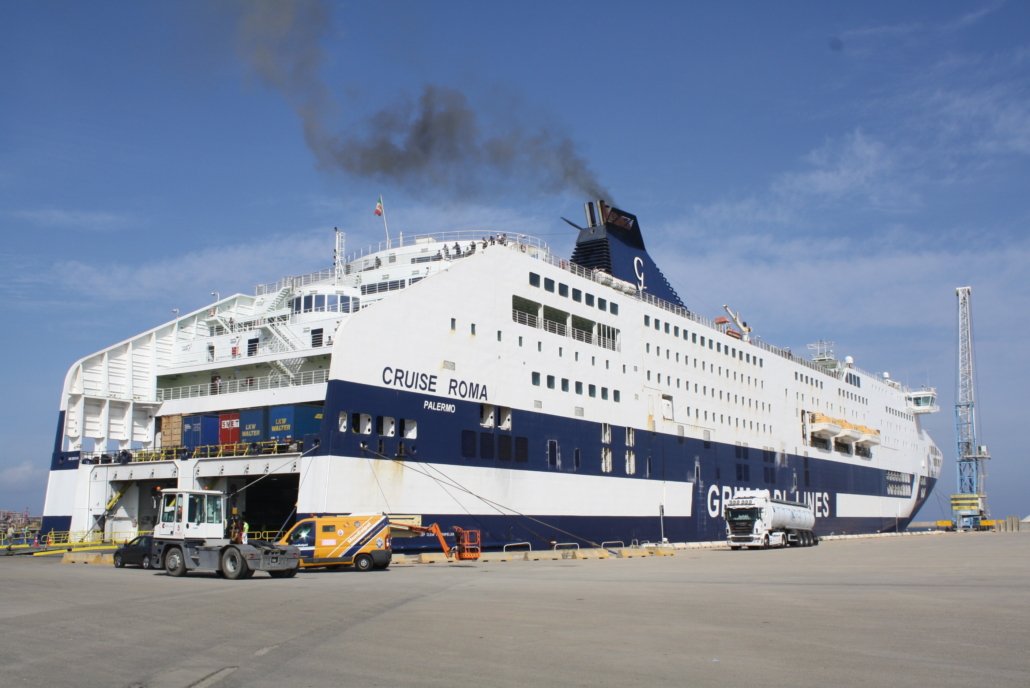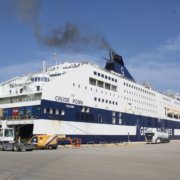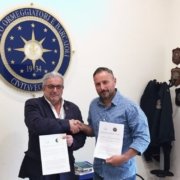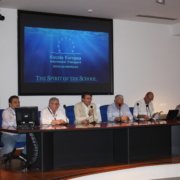#BacktoBasics: Short Sea Shipping
Short Sea Shipping (SSS) refers to the movement of cargo and passengers by sea over short distances, acting as a crucial component of intermodal transport chains. Unlike deep-sea routes that cross oceans, SSS typically operates within the same continent or between nearby countries. It serves as an efficient bridge between other modes of transport, such as road, rail, and inland waterways, facilitating seamless door-to-door services. It is a central part of intermodal transport, and this is why we are focusing on it in this month’s #BacktoBasics series.

Cruise Roma – a short sea shipping ferry berthed in the Port of Barcelona
Advantages of Short Sea Shipping
SSS offers numerous benefits over other transportation methods. Environmentally, it’s significantly cleaner, producing lower emissions per tonne of cargo moved compared to road and air transport when looking at transport emissions through a global lens. Economically, SSS can be more cost-effective, especially for bulk or heavy goods, due to lower fuel costs and economies of scale. It also alleviates congestion on busy road networks and is characterized by high reliability and safety standards.
- Environmental Benefits: One of the most compelling advantages of SSS is its reduced environmental footprint. Maritime transport emits significantly lower levels of CO2 and pollutants per tonne-kilometre of cargo transported compared to road and air transport. This makes SSS a cornerstone of sustainable logistics strategies, particularly important in the context of global efforts to combat climate change. The adoption of cleaner fuel technologies and advanced vessel designs further enhances the environmental credentials of SSS, making it an even more attractive option for eco-conscious businesses.
- Cost-effectiveness: From a financial perspective, SSS offers considerable savings, especially for bulk and heavy cargo. The economies of scale achievable with maritime transport mean that larger volumes of goods can be moved at a lower cost per unit than would be possible with road or air freight. Additionally, the indirect costs associated with road congestion and the wear-and-tear on infrastructure are significantly reduced, presenting a compelling case for businesses looking to optimize their supply chain expenses.
- Congestion Relief on Land Routes: By shifting a portion of cargo traffic from congested roadways to the sea, SSS plays a vital role in alleviating traffic congestion. This not only improves the efficiency of the transport system as a whole but also contributes to reducing accidents and delays associated with over-reliance on road transport. In urban areas, where road congestion is a significant issue, SSS can offer a practical solution to reduce pressure on land transport infrastructure.
- Reliability and Safety: Maritime transport is known for its reliability and safety record. The predictable nature of sea routes, free from the unpredictability of road traffic conditions, allows for more accurate scheduling and planning. The stringent international regulations governing maritime safety and the professional operation of vessels further ensure that cargo transported via SSS reaches its destination securely.
- Versatility and Accessibility: SSS offers unparalleled versatility, capable of accommodating a wide range of cargo types—from liquid bulk and dry bulk to containers and oversized loads. This flexibility makes it an essential component of diverse supply chains. Moreover, with the extensive network of ports and coastal routes, SSS provides access to regions and markets that might be challenging to reach via other modes of transport, thus enabling businesses to explore new opportunities and expand their reach.
- Integration with Other Modes of Transport: A key advantage of SSS is its ability to integrate seamlessly with other transport modes, such as road, rail, and inland waterways. This multimodal connectivity ensures that goods can be transported from origin to destination efficiently and cost-effectively, leveraging the strengths of each mode. For instance, SSS can be used for the main leg of transportation, with road transport covering the ‘last mile’ delivery, thus combining the cost and environmental benefits of maritime transport with the convenience and reach of road transport.
Differences Between SSS and Other Modes of Transport
While long-haul sea shipping focuses on transporting goods across oceans, SSS emphasizes shorter, more frequent services. Compared to road transport, SSS can handle higher volumes at lower costs, with less environmental impact. Against rail and air, SSS stands out for its versatility in cargo types and routes, though it may not match the speed of air freight or the land coverage of rail.
RoTypes of Traffic and Vessels in SSS
SSS employs a variety of vessels to accommodate different cargo types:
- Roll-on/Roll-off (Ro-Ro) Ships: Ideal for wheeled cargo like trucks and trailers, allowing for quick loading and unloading.
- Lift-on/Lift-off (Lo-Lo) Ships: Used for containers and bulky goods, loaded and unloaded by cranes.
- Container Ships: Specialized for containerized cargo, facilitating easy transfer between different transport modes.
- Ferries (Ro-Pax) and Barge Services: Transport both passengers and vehicles across short distances.
Key Considerations for Businesses
When integrating Short Sea Shipping (SSS) into their logistics strategies, businesses should consider the following:
- Route Selection: It’s crucial to choose SSS routes that offer dependable schedules and connect well to inland transport. Aligning these routes with the supply chain can cut down transit times and expenses.
- Cost-Benefit Analysis: SSS can be more economical than other transport methods, but businesses should weigh all costs, including tariffs and inventory expenses, against the benefits, such as reduced congestion and emissions.
- Environmental Considerations: SSS is a greener option, which companies can use to their advantage in marketing efforts and to meet sustainability goals.
- Integration with Other Transport Modes: Coordination with road, rail, and air freight is essential for the efficient movement of goods, necessitating strong partnerships with various stakeholders in the supply chain.
By carefully assessing these factors, businesses can fully leverage the advantages of SSS and enhance their overall logistics operations.
Examples and Success Stories
- The Baltic Sea Region: The Baltic Sea is a prime example of effective SSS, connecting countries like Sweden, Finland, and the Baltic states with Germany, Poland, and Russia. Services such as the Viking Line and Tallink Silja offer frequent Ro-Ro and passenger ferry services, facilitating trade and tourism. This region showcases how SSS can offer a competitive alternative to land and air transport, especially in areas with challenging geography.
- Mediterranean SSS Corridors: The Mediterranean region has developed robust SSS corridors that link European ports with North Africa and the Middle East, serving as vital links for freight and passenger movement. Companies like Grimaldi Lines or GNV operate extensive Ro-Ro, Lo-Lo, and ferry services, supporting regional trade and contributing to economic development.
- North American Great Lakes: The Great Lakes St. Lawrence Seaway System is a key SSS route in North America, allowing ships to move cargo from the Atlantic Ocean to the industrial heartland of the USA and Canada. This route demonstrates SSS’s role in supporting domestic and international trade, reducing highway traffic, and promoting economic growth in the region.
Conclusion
The future of Short Sea Shipping (SSS) looks promising as global trends lean towards more sustainable and integrated transport solutions. As businesses and governments seek to reduce carbon emissions and alleviate congestion on roads, SSS stands out as a viable and attractive option. Advancements in ship technology, such as the use of liquefied natural gas (LNG) and other alternative fuels, are making SSS even more environmentally friendly. Additionally, digitalization and the use of blockchain technology in maritime logistics are expected to enhance efficiency, transparency, and security in SSS operations.
The increasing emphasis on multimodal transport networks will further elevate the importance of SSS, making it an integral component of global supply chains. As we move towards a greener and more connected world, SSS is poised to play a pivotal role in shaping the future of transportation and logistics.
We’ve done our research – so should you! Check out our sources below to delve more deeply into the topic:
SOURCES
- European Maritime Safety Agency (EMSA): “The Environmental Benefits of Short Sea Shipping“
- International Maritime Organization (IMO): “Reducing Greenhouse Gas Emissions from Ships“
- The Baltic Sea Region Intermodal Transport Research: “Efficiency and Sustainability of SSS in the Baltic Sea.“
- United Nations Conference on Trade and Development: Short Sea Shipping and the Energy Transition”: https://unctad.org/news/short-sea-shipping-and-energy-transition
- Mediterranean Shipping Company Case Studies: “Innovative Solutions for Mediterranean Short Sea Shipping.”
- The Great Lakes St. Lawrence Seaway System: ” Great Lakes Short-Sea Shipping Could Improve US-Canada Cargo Movement”: https://maritime-executive.com/article/great-lakes-short-sea-shipping-could-improve-us-canada-cargo-movement








